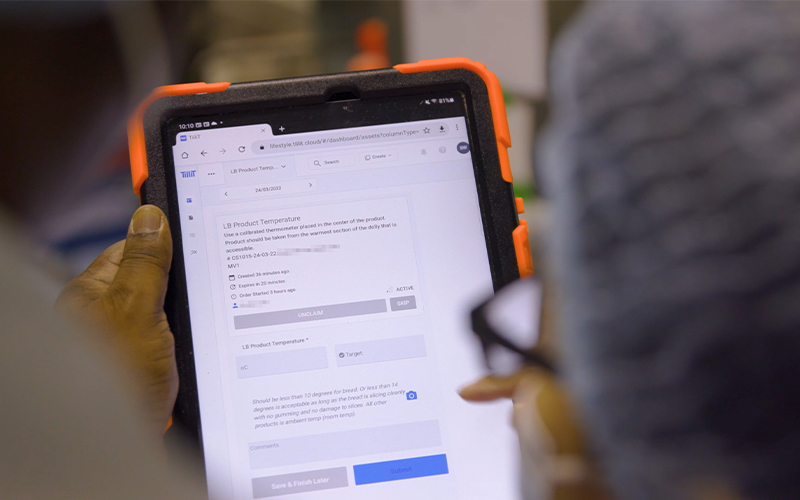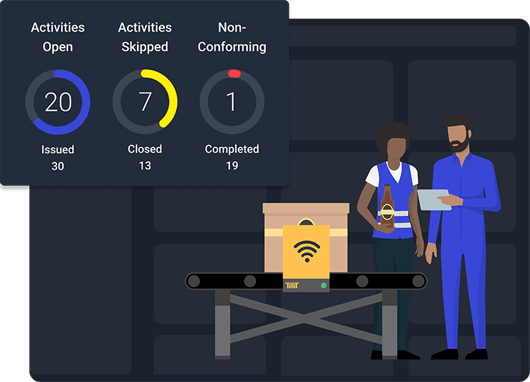
Unlocking human efficiency in smart manufacturing - Connected Frontline Workforces
Automation. OEE. IoT. Robotics. AI and machine learning. They’re all key themes inherently linked to digital transformation, and all have something in common – the focus is on machines, data, and technology.
But what about the human element?
More than 12 million people are employed in manufacturing in the U.S. and still perform nearly three-quarters of tasks in the factory. Human behavior forms a significant part of the efficiency puzzle manufacturers are trying to solve, yet, in most factories, humans are operating unguided.
Sheets of paper still clutter production lines. Operators painstakingly load data into spreadsheets and manually check machinery when failures occur. It should be no surprise that almost a quarter of downtime and nearly 70% of defects in manufacturing are caused by humans.
In this blog, I’ll explore how harnessing innovative technology to go paperless and digitalize tasks unlocks human efficiency by synchronizing processes, machinery, and people to strike the perfect smart factory balance.
Data as the holy grail is a tired concept
Data should be considered a by-product of digitalization, not the other way around. Using technology to gain meaningful insights is smart manufacturing at its core, but digitalization can have an equal or greater impact when people are the focus of our improvements.
Whole-of-view visibility across the factory is critical in providing both operators and managers with real-time insights across a production schedule and allowing them to respond to issues quickly. Achievable through a digital manufacturing platform or equivalent cloud-based software, introducing an automated digital workflow empowers the operator, shifting the focus from just the equipment to end-to-end manufacturing.

An illustration showing the difference between a traditional factory (left) vs digital operations (right).
Digital operations connect real-world information to the operator's fingertips through sensors and other IoT to synchronize events in the production run in real-time and notify staff of outstanding tasks. Digitalizing tasks helps to eliminate human error and enables real-time asset performance and OEE, digital work order management, production scheduling, and quality management – all while building a rich dataset in the back end.
It’s smart manufacturing in reverse. Paperless operations with a human-first approach. Transforming analog-to-digital data and involving the operator as a fully connected frontline worker.
Behavioral analytics: understanding human efficiency
With operational value inherently linked with human efficiency, why do we know so little about it on the shop floor? Digital platforms that model human behavior enable companies to gain visibility into human efficiencies, enabling proactive management in day-to-day operations.
A user-friendly digital workflow supports the most basic efficiency improvements without the need to dive deeper into data – if you don’t want to. Whether via laptop, tablet, or phone, an automated dynamic workflow supports operators on the assembly line in making smarter decisions.
Integrating into an operator’s daily routine, a smart digital workflow prompts them to complete tasks and respond to events and status changes in real-time, from pre-start checks, pass-fail inspections, sampling product quality, and x-ray sensor tests, right through to clean-up activities, positive release, OEE, and reporting.

Digital work order management plays an active role in enhancing human efficiency.
Connected frontline workers enabled by digital work order management provide an end-to-end cause-and-effect management process in your factory to maximize human efficiency, ensuring critical tasks across every order are completed along the way.
Retaining knowledge during the ‘Great Resignation’
In June and July 2022, the manufacturing industry saw almost 700,000 Americans walk away from industry roles (or more likely change to a new company) in a phenomenon widely known as the ‘Great Resignation’, creating a significant knowledge drain in most companies.
Skills and knowledge are just as susceptible to depreciating as physical assets if the right systems aren’t in place, and manufacturers still working without structured processes and tools that support key frontline staff may get left behind. Creating and revising paper-based SOPs and onboarding operators can take months, only for that knowledge to be lost due to high turnover rates.
Within a digital platform such as TilliT, manufacturers can capture the knowledge of their best employees in a task-oriented workflow. It effectively acts as a co-pilot, guiding everyone from the newest to most experienced employees on best practices, providing a safeguard for when processes, machinery, or staff change, and ensuring knowledge isn’t lost if a key team member leaves.
Increasing resilience and business continuity will be important as the upward trend of monthly turnover data continue to rise following a brief reprieve in 2020 as workers embraced job security during the height of the pandemic.
Digital manufacturing operations: optimizing people
Small and medium-sized enterprises make up the vast majority of all U.S. businesses. Until advanced robots are available and affordable for all SMEs people are here to stay, and some processes may never be replaced by automation and robotics.
Unlocking human efficiency by synchronizing processes, machinery, and people is digitalizing reimagined. Rather than looking for ways to replace the human presence in our factories with technology, let’s shift our thinking towards embracing technology that supports people.
Enjoyed this post? Don't forget to share!



